Drawings That Will Make You Think
As an artist, creator or hobbyist, it is hard to always have creative ideas. We caught up with illustrator Whitney Sherman to get drawing exercises to spark your creativity when you are stuck.

Whitney Sherman is an award-winning illustrator and director of the MFA in Illustration Practice at Maryland Institute College of Art. She is also author ofPlaying with Sketches, 50 creative exercises for designers and artists (Rockport Publishers). We asked Sherman for advice on how to draw and she offers up five drawing exercises from her book to help anyone get started.
If you're looking for more resources on how to hone your design skills, check out our classes on Hand Lettering, Creating a Knockout Portfolio, Logo Design, and Photoshop tutorials.
Get into the habit of making: draw inspiration from the every day. Drawing the Everyday Every Day is your guide to exploring your creativity and integrating a drawing habit into your daily routine. Learn more.
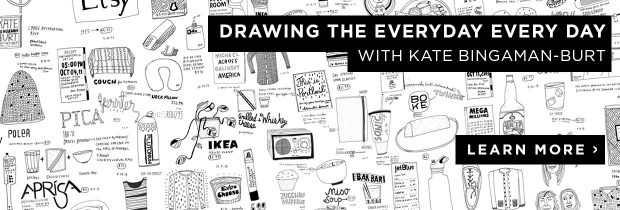
Why do you think it's so hard for people to get started with drawing or figure drawing?
For non-artists, I think that the culture of drawing is not extended or continued with or for them beyond early childhood. Grade schools and high schools, for the most part, value math and science over the arts, which gets cut out when budgetary pressures arise. What is then neglected is the haptic qualities of "making," which can contribute to retention of learning as well as foster communication. If a non-artist is only shown an example of classical or academic drawing, they will be thwarted by not having those skills. If encouraged to make native marks [draw in their own way] and be respected for that, most people would grow up with less doubt on their ability to draw and would enjoy the process, which is a very important part of drawing!
For creative people who are working in mediums other than drawing, some of the reasons are the same – recognizing and celebrating native marks, but I think it goes a bit farther to include practice. Creatively leaning people continue drawing beyond childhood for longer than most, yet their particular area of creative focus as an adult may have not required the use of drawing, and so it is left behind, unpracticed. In both cases, having permission [from a teacher, from one's self] to draw as one does, to appreciate that and practice it will foster comfort and confidence with drawing.

I had a drawing teacher in college who said, "Draw what you see, not what you know." Do you find that holds true for everyone?
Although I can't say I know how everyone behaves, I do think that extended focus is very hard for most people. Numerous conditions and environments discourage this. Have you ever been bored because it feels like nothing is happening? If so, you are probably less likely to be able to focus on what is going on around you.
The ability to quiet your mind and observe is central to the theme your teacher was addressing.Knowinginvolves conceptual thinking with additional abstract qualities based on memories of the circumstances surrounding the knowledge (Was there a smell in the air that caused us to form an opinion?).Seeing, on the other hand, requires that we participate with what is currently happening, and letting go of memory. Time is a key ingredient of seeing, although like many things, practice helps our seeing happen faster. If you purposefully act to see, you can then make the observations that allow you to translate your seeing into mark making.
Here are five step by step exercises taken fromPlaying with Sketches to help anyone get started with their drawing skills:
1) Drawing Exercise: Doodling
Anyone can do this drawing exercise, doodle and create simple shapes. It's as simple as putting pen or pencil to paper and randomly sketching anything that comes to mind. You don't even have to make straight lines. Doodles come in any shape or form, and in any color. But don't let the simplicity of this exercise fool you!
Grow your creativity with help from the world's top creatives and entrepreneurs with the Creator Pass.

Doodling increases your visual literacy and helps you process ideas, even when you are not trying! Experiment with different materials and drawing tools, and draw whatever comes to mind. You can also recruit your friend and co-workers to develop a doodle quilt using sticky notes in different colors.
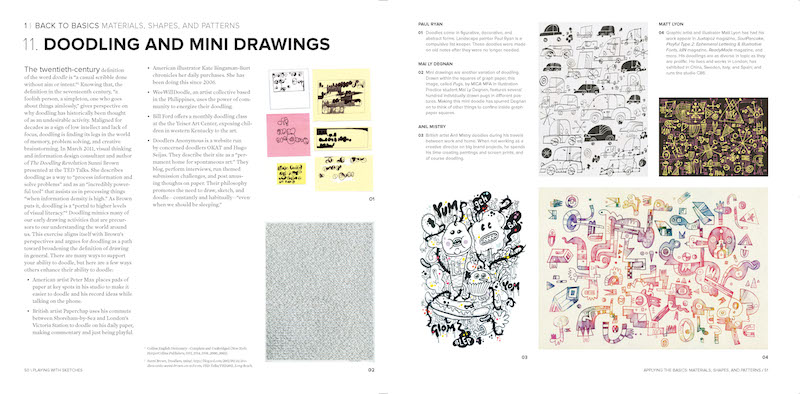
2) Drawing Exercise: Entopic Graphomania
This drawing exercise is based on a Surrealist game. Simply grab a sheet of paper—it can be a page from an old paperback book, or anything with markings—and place dots on specific words or letters. You choose what set of marks, words, or letters you want. Then connect the dots with curved, zigzag or straight lines to create a pattern. These exercises reveal hidden patterns in negative space, show you how choices can make a difference and will help you engage in randomness to take your work a few steps further.
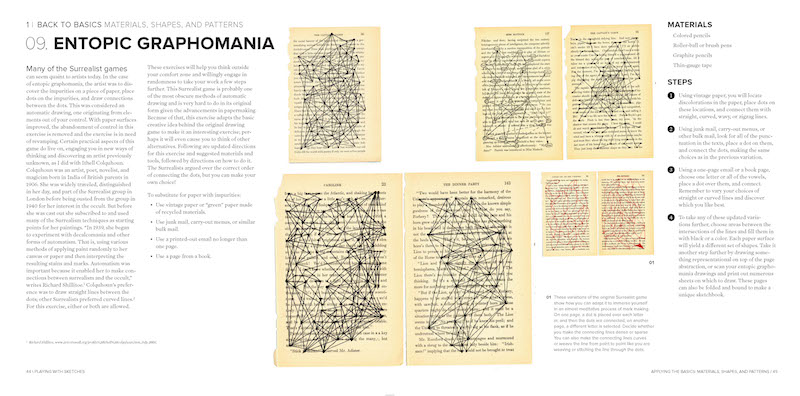
3) Drawing Exercise: Non-Dominant Hand
If you have been drawing for some time and are feeling stuck or uninspired by your marks, it may be time to reinvent in order to discover something new. Years ago I had developed a great exercise that involved rendering minute and exact details using graphite pencils on a fine surfaced drawing paper (Strathmore Drawing paper). I was bored, and so I set out to change my habit by using tools and paper that were the exact opposite—ink in a faulty dip pen on hot press paper, which is slightly spongy. I also used my non-dominant hand and no photo reference.
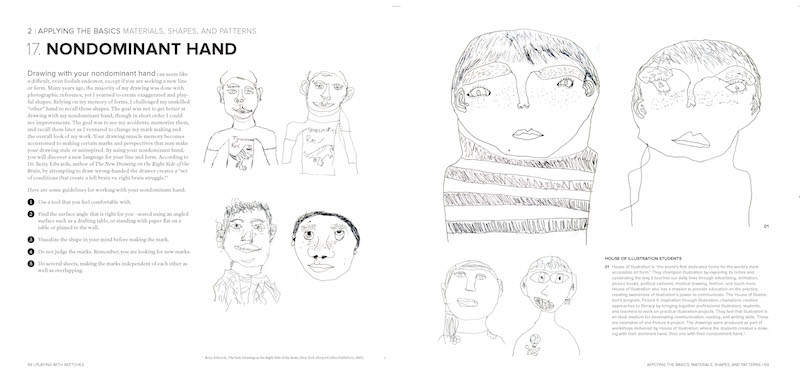
This simple exercise lasted for a few months. It felt awkward and I didn't expect anything massive to come from it, but it did! When I went back to drawing with familiar tools, I was breaking down the image in different ways and drawing with less restrictions.
4) Drawing Exercise: One Day, One Theme
For this drawing exercise, choose one theme or one kind of object, and only draw that thing during the course of a day. You can vary your approach to this by choosing an animate or inanimate object, a color, a size of something, things that are scary or make you laugh, or things that start with a specific letter.
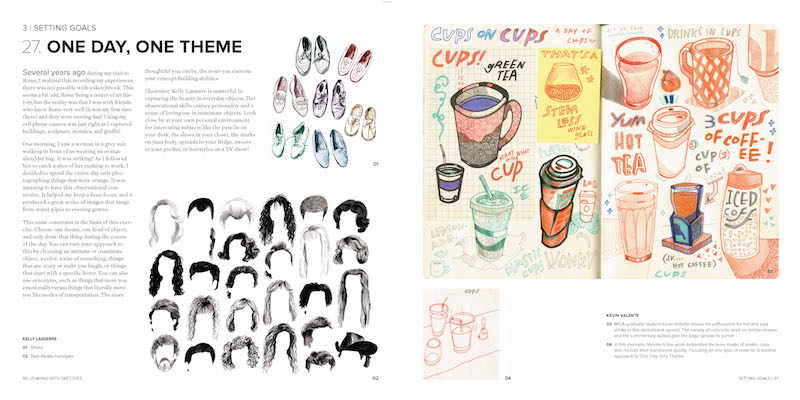
You can also use synonyms, such as things that move you emotionally versus things that literally move you, like modes of transportation. The more thoughtful you can be, the more you exercise your concept-building abilities as well as you hand skills.
5) Drawing Exercise: Word Stacks
Take 25 blank index cards and cut them into thirds. On the first stack, print an adjective on each card, on the next stack, print a noun, and on the third stack print a verb on each card. Shuffle each stack separately, then draw one card from each pile and put them next to each other, forming a phrase such as Devilish/Book/Laughing. Then draw it! It might not turn into fine art but it will help cultivate basic skills and build your confidence in the craft.

Get into the habit of making: draw inspiration from the every day. Drawing the Everyday Every Day is your guide to exploring your creativity and integrating a drawing habit into your daily routine. Learn more.

Emily Potts FOLLOW >
Emily J. Potts has been a writer and editor in the design industry for more than 20 years. Currently she is an independent writer working for a variety of clients in the design industry. www.emilyjpotts.com
Drawings That Will Make You Think
Source: https://www.creativelive.com/blog/5-drawing-exercises-turn-make-anyone-artist/
Posted by: lomaxpoccour.blogspot.com

0 Response to "Drawings That Will Make You Think"
Post a Comment